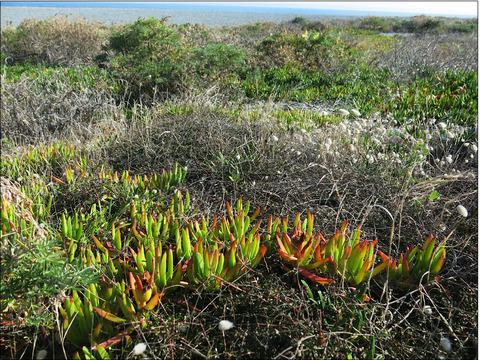Our official English website, www.x-mol.net, welcomes your feedback! (Note: you will need to create a separate account there.)
A habitat‐based assessment of the role of competition in plant invasions
Journal of Ecology ( IF 5.5 ) Pub Date : 2020-11-07 , DOI: 10.1111/1365-2745.13553 Jason D. Fridley 1 , Insu Jo 2 , Philip E. Hulme 3 , Richard P. Duncan 4
中文翻译:

对竞争在植物入侵中的作用的基于栖息地的评估
更新日期:2020-11-07
Journal of Ecology ( IF 5.5 ) Pub Date : 2020-11-07 , DOI: 10.1111/1365-2745.13553 Jason D. Fridley 1 , Insu Jo 2 , Philip E. Hulme 3 , Richard P. Duncan 4
Affiliation

|
- Many invasion theories invoke resource competition as the primary mechanism of invader advantage. These include Darwin's naturalization hypothesis (DNH), which treats phylogenetic similarity as a proxy for niche overlap and competitive intensity, and the evolutionary imbalance hypothesis (EIH), which suggests the phylogenetic diversity (PD) of an introduced species’ native range is an indicator of its competitive ability.
- Few tests of invasion theory, however, consider habitat characteristics associated with the role of competition in community assembly. In particular, plant invasions of habitats characterized by high environmental stress and disturbance levels should rarely be driven by competition. This suggests tests of EIH and DNH are habitat dependent, and their relative importance in invasiveness models should be predictable based on habitat qualities related to competitive intensity.
- Using a dataset of plant invasions in New Zealand (NZ) natural areas that distinguishes naturalized species according to both habitat type and community impact, we evaluated the predictive ability of factors related to EIH, DNH and covariates including year of introduction, introduction mode and life history attributes, in driving species invasiveness. We hypothesized that EIH and DNH would be more important predictors of invasiveness in forested habitats and decline in importance as communities shifted towards those more dominated by herbaceous species and/or more sparsely vegetated.
- We found mixed support for the role of competition linked to DNH and EIH as a driver of invasions in relation to habitat type. Native range PD was among the best predictors of invasiveness in forests, and declined in importance in more disturbed habitats, supporting EIH. In contrast, phylogenetic nearest neighbour distance (PNND) of invaders to native communities was more important in disturbed environments, suggesting competition does not drive DNH. Further, for most habitats and across all of NZ, neither PD nor PNND was as important as year of introduction or life history and growth form attributes in predicting invasiveness.
- Synthesis. Although both native range PD and PNND predict the invasiveness of naturalized plants in NZ, the results of our habitat‐specific models indicate that only PD is consistent with an invasion mechanism based on competitive ability. Effects of PNND were greatest in grasslands that have been extensively modified by fire and grazing, suggesting they are more likely driven by invader pre‐adaptation to modified habitat conditions. Due to the importance of matching species' traits to environmental context, invasiveness risk assessments perform better when applied to invaders of particular habitats.
中文翻译:

对竞争在植物入侵中的作用的基于栖息地的评估
- 许多入侵理论将资源竞争称为入侵者优势的主要机制。其中包括达尔文的归化假设(DNH)(将系统相似性视为小生境重叠和竞争强度的代表),以及进化失衡假设(EIH),其表明引入物种的本地范围的系统发育多样性(PD)是一个指标竞争能力。
- 但是,很少有关于入侵理论的测验考虑与竞争在社区集会中的作用有关的栖息地特征。尤其是,以高环境压力和干扰水平为特征的栖息地的植物入侵很少应由竞争来驱动。这表明EIH和DNH的测试依赖于栖息地,并且根据与竞争强度相关的栖息地质量,可以预测它们在侵入性模型中的相对重要性。
- 我们使用新西兰自然地区的植物入侵数据集(根据栖息地类型和社区影响来区分归化物种),评估了与EIH,DNH和相关变量(包括引入年份,引入方式和寿命)相关的预测能力历史属性,驱动物种入侵。我们假设EIH和DNH将是森林栖息地入侵程度的更重要预测指标,并且随着社区向以草本物种为主和/或植被更加稀疏的社区转变,EIH和DNH的重要性将下降。
- 我们发现,与DNH和EIH相关的竞争在生境类型相关的入侵驱动因素中的作用得到了混合支持。原生PD是森林入侵力的最佳预测指标之一,而在受干扰更严重的栖息地中重要性下降,从而为EIH提供了支持。相反,在受干扰的环境中,入侵者到本地社区的系统发育最近邻居距离(PNND)更重要,这表明竞争并不会驱使DNH。此外,对于大多数生境和整个新西兰地区,PD和PNND在预测入侵性方面都没有引入年或生命史和生长形式属性那么重要。
- 综合。尽管自然范围的PD和PNND都可以预测新西兰自然化植物的入侵性,但我们针对特定栖息地的模型的结果表明,只有PD与基于竞争能力的入侵机制相一致。PNND的影响在经过大火和放牧大量修改的草原上最为明显,表明它们更可能是由入侵者预先适应修改后的栖息地条件驱动的。由于将物种的性状与环境相匹配的重要性,将入侵性风险评估应用于特定生境的入侵者时,评估效果更好。



























 京公网安备 11010802027423号
京公网安备 11010802027423号